Antique brass weighing scales
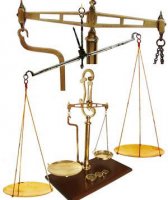 By Merav Schejtman-Gilai
By Merav Schejtman-Gilai
The rapid development of electronics and computerization in the mid 20th century, and
the invention of the digital scales, crowded out, almost entirely the use of mechanical scales.
Because of this, the mechanical scales became collectors’ items. Most mechanical scales are works of art, and are hand crafted. The work is precise and gives an authentic feel of the era in which they were created.
Equal Arm Beam Balances
The simplest type of balance, the equal-arm, or beam, balance has been used for many thousands of years as an application of a simple lever. The Beam, Fulcrum and Pointer. A uniform bar, the beam, is suspended at its exact center on a knife-edge hinge set at right angles to it. This point of support is called the fulcrum. Two pans of equal weight are suspended from the beam, one at each end, at points equally distant from the fulcrum.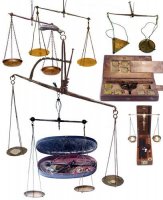 Since the center of gravity of a uniform bar is at its midpoint, the beam supporting the pans will be in equilibrium when it is exactly horizontal. A pointer attached at right angle to the beam at the fulcrum indicates zero on a scale when the beam is at rest parallel to a level surface. It shows also the extent of swing of the beam on one side or the other, acting somewhat as a pendulum, when the beam is coming to rest. The object to be weighed is placed on one pan, and standard weights are added to the other until the balance of the beam is established again. The unknown weight can then be determined by adding up the standard weights in the pan. Sensitivity. The sensitivity of the scales depends on 3 main factors: a) the amount of friction in the different hinges. The less friction there is, the more sensitive the scale. The knife-edged fulcrum serves this purpose. B) The total mass of the different parts of the scale. This is probably the reason for using brass to construct various parts of the scales. C) The length of the main beam.
Since the center of gravity of a uniform bar is at its midpoint, the beam supporting the pans will be in equilibrium when it is exactly horizontal. A pointer attached at right angle to the beam at the fulcrum indicates zero on a scale when the beam is at rest parallel to a level surface. It shows also the extent of swing of the beam on one side or the other, acting somewhat as a pendulum, when the beam is coming to rest. The object to be weighed is placed on one pan, and standard weights are added to the other until the balance of the beam is established again. The unknown weight can then be determined by adding up the standard weights in the pan. Sensitivity. The sensitivity of the scales depends on 3 main factors: a) the amount of friction in the different hinges. The less friction there is, the more sensitive the scale. The knife-edged fulcrum serves this purpose. B) The total mass of the different parts of the scale. This is probably the reason for using brass to construct various parts of the scales. C) The length of the main beam.
Modifications of Equal arm scales.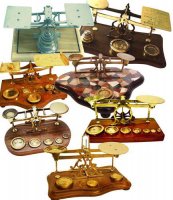 Equal arm scales and balances were made for many different usage such as weighing money, gold silver and diamonds, grocery, postal parcels, chemicals etc. The details of each scale were modified and adapted to its specific use. These adaptations involved inventing new ideas that changed the classical form of Equal Arm beam. An example of such modification is the Roberval Scales: In order to place the scales on a table and lessen the friction, a mathematician called M. Gilles de Roberval invented in 1730 scales with two main beams and load platforms located on top of the beams, one at each end. These scales had two central hinges, which lessened the stress on the main hinge by half, and the precision grew immensely. Manufacturing Roberval scales with the pans above the beam started only at the beginning of the 19th century. This development allowed the scales to be placed on a table or shelf and therefore simplify the weighing process. These types of scales caught on very fast and were soon seen in market stalls and post offices.
Equal arm scales and balances were made for many different usage such as weighing money, gold silver and diamonds, grocery, postal parcels, chemicals etc. The details of each scale were modified and adapted to its specific use. These adaptations involved inventing new ideas that changed the classical form of Equal Arm beam. An example of such modification is the Roberval Scales: In order to place the scales on a table and lessen the friction, a mathematician called M. Gilles de Roberval invented in 1730 scales with two main beams and load platforms located on top of the beams, one at each end. These scales had two central hinges, which lessened the stress on the main hinge by half, and the precision grew immensely. Manufacturing Roberval scales with the pans above the beam started only at the beginning of the 19th century. This development allowed the scales to be placed on a table or shelf and therefore simplify the weighing process. These types of scales caught on very fast and were soon seen in market stalls and post offices.
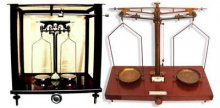
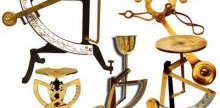
Related posts:

 One of the more cost-effective measurements in a paper mill is that which monitors the flow of pulp stock into the head box of the paper machine. The stock level…
One of the more cost-effective measurements in a paper mill is that which monitors the flow of pulp stock into the head box of the paper machine. The stock level… Overview Marel Marine Scales are specifically designed for use on board fishing vessels and factory trawlers. This cost-effective series of scales ranges from the…
Overview Marel Marine Scales are specifically designed for use on board fishing vessels and factory trawlers. This cost-effective series of scales ranges from the… How long to air fry french fries what does fafsa stand for What does it mean when ypu use alocohol and the tips of your fingers turn white Who raps bitches aint…
How long to air fry french fries what does fafsa stand for What does it mean when ypu use alocohol and the tips of your fingers turn white Who raps bitches aint… Globe s portion control scales can be used in a wide spectrum of applications from delis and pizza parlors, to bakeries and restaurants, or any establishment where…
Globe s portion control scales can be used in a wide spectrum of applications from delis and pizza parlors, to bakeries and restaurants, or any establishment where… How to get bubbles out of screen protector? Totally add add tips and tricks how to eat an elephant list What are all the tricks you can have in trickerion board…
How to get bubbles out of screen protector? Totally add add tips and tricks how to eat an elephant list What are all the tricks you can have in trickerion board…